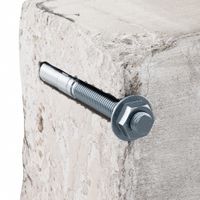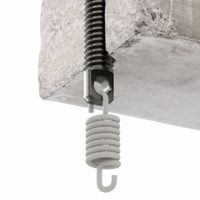Call +(254) 703 030 000 / 751 483 999 / 721 704 777
.....Read More
Frequently Asked Questions
What are the different types of anchors for concrete, block, and brick?
There are various types of anchors designed for concrete, block, and brick, each suited for different applications and load requirements.
For concrete, common anchors include: * Wedge Anchors: Ideal for heavy-duty applications, they expand and create a strong bond when tightened.
* Sleeve Anchors: Versatile for medium to heavy loads, they work by expanding a sleeve against the drilled hole.
* Drop-in Anchors: Used for flush mounting, a setting tool expands the anchor within the hole.
* Undercut Anchors: Offer high pull-out resistance, especially in critical applications, by creating an interlock within the concrete.For block and brick (masonry), which are typically more brittle than concrete, different types of anchors are preferred: * Toggle Bolts: Excellent for hollow block, they have wings that open behind the material to distribute the load.
* Sleeve Anchors (specifically designed for masonry): Similar to concrete sleeve anchors but optimized for the properties of block and brick.
* Hammer Drive Anchors: Quick to install for light to medium loads, they are driven into a pre-drilled hole.
* Plastic/Nylon Plugs (with screws): Best for light-duty applications, these expand as a screw is driven into them.
* Chemical Anchors/Adhesive Anchors: Offer very strong bonds in both solid and hollow masonry by using a resin that cures around a threaded rod.The choice of anchor depends on the substrate material, the weight of the item being fastened, and environmental conditions.
How do adhesive anchors work and when should they be used?
Adhesive anchors, also known as chemical anchors or resin anchors, work by creating a strong bond between a threaded rod or rebar and the base material (concrete, masonry, or stone). This bond is achieved through a chemical reaction between the resin and a hardener, which cures and hardens to create a secure connection.
The process typically involves drilling a hole in the base material, cleaning the hole thoroughly to remove dust and debris, and then injecting the adhesive resin into the hole. The anchor element is then inserted into the resin, and as the adhesive cures, it expands slightly to fill any irregularities in the hole, creating an incredibly strong and durable bond.
Adhesive anchors are particularly useful in situations where mechanical anchors might not be suitable, such as when dealing with fragile or cracked base materials, or when high loads need to be sustained. They are commonly used for: * **Heavy-duty applications:** Securing structural steel, machinery, and safety barriers.
* **Seismic and dynamic loads:** Their flexibility can better absorb vibrations compared to rigid mechanical anchors.
* **Close-edge installations:** They reduce the risk of concrete spalling compared to expansion anchors.
* **Corrosive environments:** Certain formulations offer excellent resistance to chemicals and moisture.
* **Renovation and repair:** For anchoring new elements to existing structures without causing damage.They are an excellent choice for applications requiring high load-bearing capacity and a reliable, long-lasting connection.
What is the best type of anchor for drywall and plaster?
For drywall and plaster, the best type of anchor depends on the weight of the object you're hanging.
For lightweight items (under 10 lbs): * **Self-drilling drywall anchors (threaded anchors):** These are easy to install, requiring no pre-drilling. They screw directly into the drywall and are good for pictures, small shelves, or light decor.
* **Plastic expansion anchors (conical anchors):** These require a small pilot hole. As you drive a screw into them, they expand to create a secure hold. Suitable for similar lightweight applications as self-drilling anchors.For medium-weight items (10-25 lbs): * **Toggle bolts (butterfly anchors):** These are excellent for heavier items. You drill a hole, insert the collapsed toggle, and it springs open behind the wall. As you tighten the screw, it pulls the wings tight against the back of the drywall, distributing the weight over a larger area. They are very strong but require a larger hole.
* **Molly bolts (hollow-wall anchors):** These are metal anchors with a pointed end. You hammer them into the wall, and as you tighten the screw, the body of the anchor expands and grips the back of the drywall. They offer good holding power and are removable.For heavy items (over 25 lbs) or for hanging on plaster: * **Toggle bolts (metal spring toggles):** These remain the best option for heavy items in drywall due to their superior weight distribution.
* **Specific plaster anchors:** Plaster is more brittle than drywall. For very heavy items in plaster, it's often best to try to locate a wall stud and screw directly into it. If a stud isn't available, specialized plaster anchors or larger, more robust toggle bolts may be necessary, but exercise caution to avoid cracking the plaster.Always check the weight rating of the anchor and ensure it matches the weight of the object you intend to hang. Using the correct size drill bit for pilot holes is also crucial for proper installation and maximum holding power.
How do you install a rod hanger into a mounting surface?
To install a rod hanger into a mounting surface, first select the appropriate type of rod hanger and mounting hardware for your specific application and the type of surface (e.g., wood, concrete, drywall). Mark the precise location for the hanger on the surface, ensuring it's properly aligned. If installing into wood, pre-drill pilot holes if necessary to prevent splitting. For concrete or masonry, you'll need a hammer drill and appropriate masonry anchors. For drywall, use toggle bolts or similar anchors that expand behind the surface for secure fastening. Once the holes are prepared, position the rod hanger and secure it with the chosen screws or bolts, tightening them until the hanger is firmly attached. Ensure the hanger is level and capable of supporting the intended load before attaching any rods or suspended items.
What are the advantages of using spring anchors?
Spring anchors, also known as toggle anchors or butterfly anchors, are designed to provide secure fastening in hollow walls or ceilings, such as drywall or plaster. Their primary advantage lies in their ability to create a strong, load-bearing connection where traditional screws or nails would fail due to the lack of a solid stud.
When inserted into a pre-drilled hole, the "wings" or toggles of the anchor expand behind the wall surface, distributing the weight over a larger area. This expansion provides a much more stable and secure hold than a simple friction fit. This makes them ideal for hanging heavy items like televisions, shelving units, curtain rods, or light fixtures without fear of them pulling out.
Another benefit is their versatility. They can be used in a variety of materials with hollow cavities, and many designs allow for easy installation without specialized tools. They are also useful when the exact location of a wall stud is unknown or inconvenient. While they create a larger hole than some other anchors, their strength and reliability often outweigh this minor drawback for applications requiring significant support.
How do you determine the load capacity of an anchor?
Determining the load capacity of an anchor involves several factors to ensure safety and effectiveness. Key considerations include the anchor type (e.g., wedge, sleeve, drop-in), the base material into which it's installed (e.g., concrete, brick, block), and the specific application's load requirements (tension, shear, or combined).
Manufacturers provide technical data sheets with published ultimate and allowable load values for their anchors in various base materials. These values are typically derived from extensive testing under controlled conditions. When using these values, it's crucial to apply appropriate safety factors, as real-world conditions can vary.
The condition of the base material is paramount; cracks, voids, or low-strength material can significantly reduce an anchor's capacity. Installation procedure also plays a critical role. Proper hole diameter, embedment depth, and torqueing (for mechanical anchors) are essential for achieving the stated load capacities. Over-tightening or under-tightening can compromise performance.
Environmental factors like temperature, moisture, and chemical exposure can also affect long-term anchor performance. For critical applications, on-site proof loading or pull-out tests may be conducted to verify anchor performance in the actual substrate. Consulting with a structural engineer is recommended for complex or high-load applications.
What are the common mistakes to avoid when installing anchors?
To avoid common mistakes when installing anchors, ensure you select the correct anchor type for the substrate (e.g., concrete, drywall, masonry) and the load it will bear. Always use the manufacturer's recommended drill bit size, as an incorrect size can compromise holding power. Drill the hole to the specified depth, and clean it thoroughly of dust and debris before inserting the anchor. Over-tightening or under-tightening can lead to failure; follow torque specifications or tighten until snug for mechanical anchors, and ensure proper cure time for chemical anchors. Finally, consider edge distance and spacing to prevent spalling or weakening of the substrate when installing multiple anchors.
How do you remove an anchor from a masonry surface?
Removing an anchor from a masonry surface depends on the type of anchor. For sleeve anchors, you can typically unscrew the nut and washer, then gently tap the anchor shaft with a hammer until it loosens, allowing you to pull it out. If it's stubborn, you might need to use pliers to grip and twist while pulling. For wedge anchors, you'll also unscrew the nut and washer. These anchors expand within the hole, so they can be trickier. Sometimes, you can use a claw hammer or a pry bar to leverage them out. If the anchor is deeply embedded or a different type (like a drop-in or chemical anchor), you might need to drill around it with a masonry bit that's slightly larger than the anchor's diameter, being careful not to damage the surrounding masonry. Alternatively, you could try to break up the anchor within the hole using a punch and hammer, then clean out the debris. Always wear appropriate safety gear, including eye protection and gloves.
What is the difference between mechanical and chemical anchors?
Mechanical anchors create a connection by friction or positive interlock within the base material, such as expansion anchors that expand to grip the sides of a drilled hole. They are typically faster to install and can be used in a wider range of temperatures. Chemical anchors, on the other hand, rely on a resin that chemically bonds the anchor to the base material. This creates a very strong, waterproof seal and distributes the load over a larger area, reducing stress on the base material. They are often preferred for critical applications, in corrosive environments, or in softer materials where mechanical anchors might cause cracking. However, they require curing time and are sensitive to temperature and moisture during installation.
How do you choose the right anchor for a specific application?
Choosing the right anchor involves considering several factors to ensure safety and effectiveness. First, assess the material you're anchoring into. Different anchors are designed for various substrates like drywall, concrete, brick, or wood. For instance, toggle bolts or self-drilling anchors work well in drywall, while wedge anchors or sleeve anchors are better for concrete.
Next, consider the weight and type of load the anchor will support. Is it a static load (e.g., a picture frame) or a dynamic load (e.g., a swing)? The shear strength (resistance to sideways force) and pull-out strength (resistance to outward force) of the anchor are crucial here. Always check the manufacturer's load ratings.
The environmental conditions also play a role. If the application is outdoors or in a corrosive environment, stainless steel anchors or those with special coatings will be necessary to prevent rust and degradation.
Finally, think about the installation process and available tools. Some anchors require pre-drilling specific hole sizes, while others are hammer-driven. Ensure you have the correct drill bits, wrenches, or setting tools for a proper installation. Always follow the manufacturer's instructions for optimal performance and safety.




